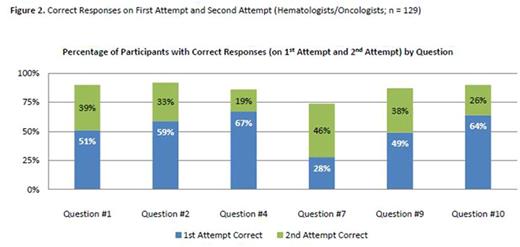Abstract
Introduction/Background:
Recent advances in the understanding and treatment of multiple myeloma (MM) have led to improvements in patient management, including stratifying patients according to disease- and patient-specific risk factors, identifying appropriate patients for autologous stem cell transplantation, selecting treatment and incorporating new therapies into practice, and managing adverse effects.
Materials and Methods: An online educational program using clinical problem-based instruction methodology was developed for hematologists and posted November 30, 2015 (http://www.medscape.org/viewarticle/853712). Each patient case included interactivity in the form of clinical decision questions and knowledge assessmentquestions. Tailored feedback and potential consequences in response to clinical decision questions was provided to each learner. Learners who answered a question incorrectly on the first attempt were provided feedback without revealing the correct answer and given the opportunity to answer the question again (second attempt) [Figure 1]. To determine measurable improvements in competence and clinical decision making, first and second attempt answer choices were evaluated for the clinical decision questions. Overall effect size was calculated using Cohen's d to show the magnitude and strength of the consequence-based feedback learning method. Data were collected through February 17, 2016.
Results: A total of 404 hematologists participated in the activity during the study period, and responses from 129 (those who completed all clinical decision questions) were assessed. Responses to the 6 clinical decision questions show that a range of 28% to 67% of learners answered a question correctly on the first attempt. After receiving feedback specific to each incorrect answer, there was an overall 71% relative improvement in hematologists/oncologists who answered a question correctly on the second attempt [Figure 2]. The consequence-based feedback had a large impact on hematologists' ability to make clinical decisions correctly as demonstrated by the overall effect size of d=.94.
Conclusions: This study demonstrated the success of a web-based CME activity with tailored feedback to learners' responses. Participation in this activity led to large improvements in clinician knowledge and the ability to select appropriate evidence- based practice choices, which may ultimately improve outcomes of patients being treated for multiple myeloma.
No relevant conflicts of interest to declare.
Author notes
Asterisk with author names denotes non-ASH members.



This feature is available to Subscribers Only
Sign In or Create an Account Close Modal